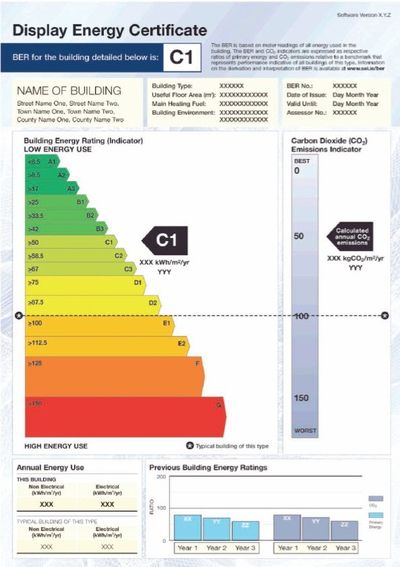All non-domestic buildings in Ireland require a Building Energy Rating (BER) Certificate and Advisory Report when the building is constructed, sold or rented.
The BER is an indicator of energy performance covering energy use for space heating and cooling, water heating, ventilation and lighting, calculated on the basis of standard operating patterns. It is accompanied by a CO2 emissions indicator. The Advisory report accompanying the BER gives recommendations for improvements that can be made to improve the energy rating of the building. More information on the Non-Domestic Building Energy Rating can be found here on SEAI's website.
Easlár are registered BER Assessors with SEAI. If you require a Commercial BER Assessment, please do not hesitate tocontact us.
Easlár are registered DEC Assessors with SEAI. If you require a Display Energy Certificate, please contact us at info@easlar.com
Display Energy Certificates (DECs)
From the 9th January 2013 publicly and privately-owned buildings over 500m2, frequently visited by the public, are required to exhibit a DEC, in a prominent place, clearly visible to the public. The DEC is intended to encourage public authorities to adopt environmentally responsible and efficient use of energy in buildings.
The DEC is based on measured energy use, where the actual energy consumed in the building is compared to a benchmark for similar buildings and shown on the certificate A1 - G scale in terms of primary energy. There is also a CO2 indicator which shows the CO2 emissions associated with the building's energy consumption.
The DEC rating is calculated on the basis of the ACTUAL energy consumption, during occupation, over a ONE YEAR period. The DEC reflects the use of the building and the practices of management and maintenance. This is calculated from meter readings/ bills or an alternative reliable source. From this, an operational rating is derived. The energy used by the building over the year is required. This may include gas fuels, oil fuels, solid fuels, district heating and cooling and electricity. Energy consumption is ideally obtained directly from onsite incoming energy meters, or from energy supply company bills. If this information is not available from those maintaining the building or the landlord, an estimate should be provided from the energy supplier.




